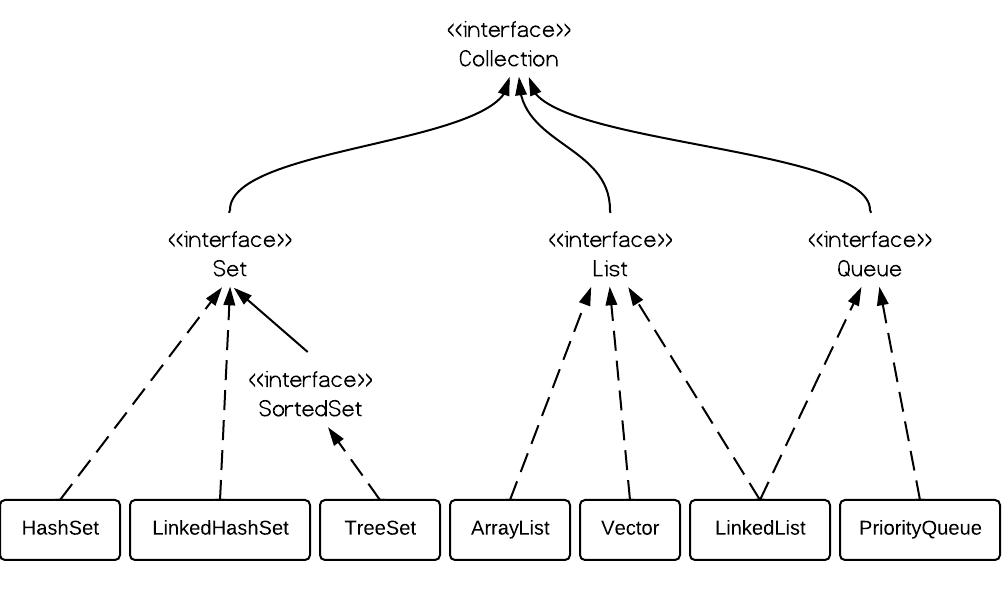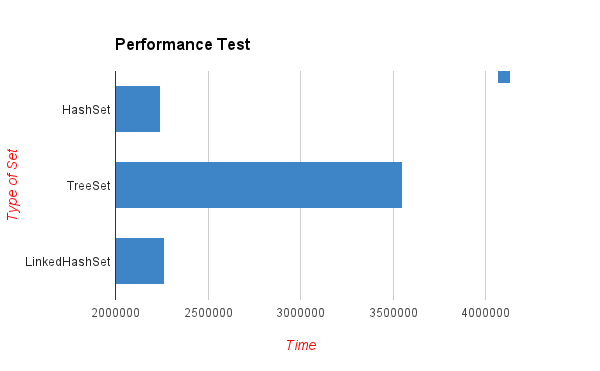标签:
A Set contains no duplicate elements. That is one of the major reasons to use a set. There are 3 commonly used implementations of Set: HashSet, TreeSet and LinkedHashSet. When and which to use is an important question. In brief, if you need a fast set, you should use HashSet; if you need a sorted set, then TreeSet should be used; if you need a set that can be store the insertion order, LinkedHashSet should be used.
1. Set Interface
Set interface extends Collection interface. In a set, no duplicates are allowed. Every element in a set must be unique. You can simply add elements to a set, and duplicates will be removed automatically.

2. HashSet vs. TreeSet vs. LinkedHashSet
HashSet is Implemented using a hash table. Elements are not ordered. The add, remove, andcontains methods have constant time complexity O(1).
TreeSet is implemented using a tree structure(red-black tree in algorithm book). The elements in a set are sorted, but the add, remove, and contains methods has time complexity of O(log (n)). It offers several methods to deal with the ordered set like first(), last(), headSet(), tailSet(), etc.
LinkedHashSet is between HashSet and TreeSet. It is implemented as a hash table with a linked list running through it, so it provides the order of insertion. The time complexity of basic methods is O(1).
3. TreeSet Example
TreeSet<Integer> tree = new TreeSet<Integer>();
tree.add(12);
tree.add(63);
tree.add(34);
tree.add(45);
Iterator<Integer> iterator = tree.iterator();
System.out.print("Tree set data: ");
while (iterator.hasNext()) {
System.out.print(iterator.next() + " ");
}
|
Output is sorted as follows:
Tree set data: 12 34 45 63
Now let‘s define a Dog class as follows:
class Dog {
int size;
public Dog(int s) {
size = s;
}
public String toString() {
return size + "";
}
}
|
Let‘s add some dogs to TreeSet like the following:
import java.util.Iterator;
import java.util.TreeSet;
public class TestTreeSet {
public static void main(String[] args) {
TreeSet<Dog> dset = new TreeSet<Dog>();
dset.add(new Dog(2));
dset.add(new Dog(1));
dset.add(new Dog(3));
Iterator<Dog> iterator = dset.iterator();
while (iterator.hasNext()) {
System.out.print(iterator.next() + " ");
}
}
}
|
Compile ok, but run-time error occurs:
Exception in thread "main" java.lang.ClassCastException: collection.Dog cannot be cast to java.lang.Comparable at java.util.TreeMap.put(Unknown Source) at java.util.TreeSet.add(Unknown Source) at collection.TestTreeSet.main(TestTreeSet.java:22)
Because TreeSet is sorted, the Dog object need to implement java.lang.Comparable‘scompareTo() method like the following:
class Dog implements Comparable<Dog>{
int size;
public Dog(int s) {
size = s;
}
public String toString() {
return size + "";
}
@Override
public int compareTo(Dog o) {
return size - o.size;
}
}
|
The output is:
1 2 3
4. HashSet Example
HashSet<Dog> dset = new HashSet<Dog>();
dset.add(new Dog(2));
dset.add(new Dog(1));
dset.add(new Dog(3));
dset.add(new Dog(5));
dset.add(new Dog(4));
Iterator<Dog> iterator = dset.iterator();
while (iterator.hasNext()) {
System.out.print(iterator.next() + " ");
}
|
Output:
5 3 2 1 4
Note the order is not certain.
5. LinkedHashSet Example
LinkedHashSet<Dog> dset = new LinkedHashSet<Dog>();
dset.add(new Dog(2));
dset.add(new Dog(1));
dset.add(new Dog(3));
dset.add(new Dog(5));
dset.add(new Dog(4));
Iterator<Dog> iterator = dset.iterator();
while (iterator.hasNext()) {
System.out.print(iterator.next() + " ");
}
|
The order of the output is certain and it is the insertion order:
2 1 3 5 4
6. Performance testing
The following method tests the performance of the three class on add() method.
public static void main(String[] args) {
Random r = new Random();
HashSet<Dog> hashSet = new HashSet<Dog>();
TreeSet<Dog> treeSet = new TreeSet<Dog>();
LinkedHashSet<Dog> linkedSet = new LinkedHashSet<Dog>();
// start time
long startTime = System.nanoTime();
for (int i = 0; i < 1000; i++) {
int x = r.nextInt(1000 - 10) + 10;
hashSet.add(new Dog(x));
}
// end time
long endTime = System.nanoTime();
long duration = endTime - startTime;
System.out.println("HashSet: " + duration);
// start time
startTime = System.nanoTime();
for (int i = 0; i < 1000; i++) {
int x = r.nextInt(1000 - 10) + 10;
treeSet.add(new Dog(x));
}
// end time
endTime = System.nanoTime();
duration = endTime - startTime;
System.out.println("TreeSet: " + duration);
// start time
startTime = System.nanoTime();
for (int i = 0; i < 1000; i++) {
int x = r.nextInt(1000 - 10) + 10;
linkedSet.add(new Dog(x));
}
// end time
endTime = System.nanoTime();
duration = endTime - startTime;
System.out.println("LinkedHashSet: " + duration);
}
|
From the output below, we can clearly wee that HashSet is the fastest one.
HashSet: 2244768 TreeSet: 3549314 LinkedHashSet: 2263320
* The test is not precise, but can reflect the basic idea that TreeSet is much slower because it is sorted.

HashSet vs. TreeSet vs. LinkedHashSet
标签:
原文地址:http://www.cnblogs.com/Guoyutian/p/5185618.html